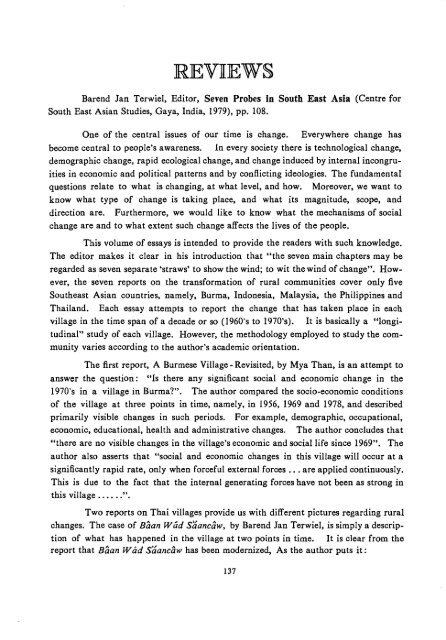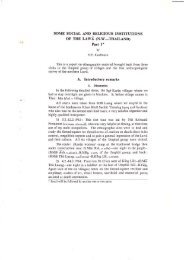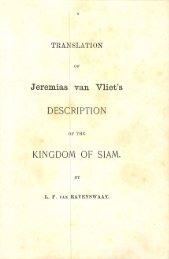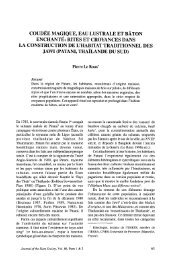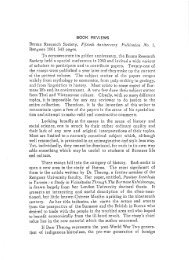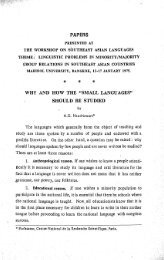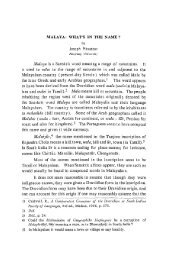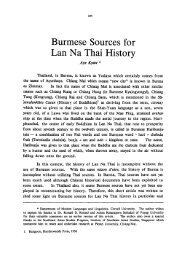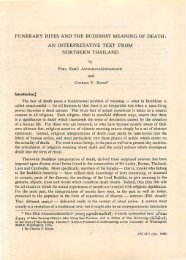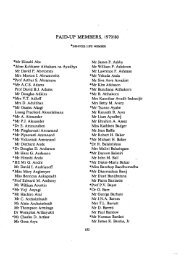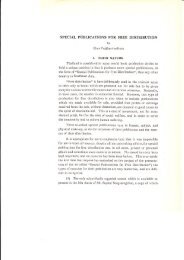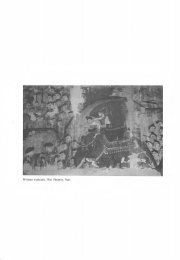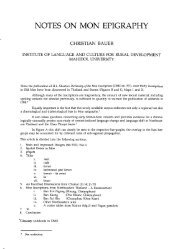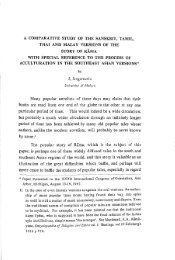REVKJEWS - Siamese Heritage Protection Program
REVKJEWS - Siamese Heritage Protection Program
REVKJEWS - Siamese Heritage Protection Program
You also want an ePaper? Increase the reach of your titles
YUMPU automatically turns print PDFs into web optimized ePapers that Google loves.
<strong>REVKJEWS</strong><br />
Barend Jan Terwiel, Editor, Seven Probes in South East Asia (Centre for<br />
South East Asian Studies, Gaya, India, 1979), pp. 108.<br />
One of the central issues of our time is change. Everywhere change has<br />
become central to people's awareness. In every society there is technological change,<br />
demographic change, rapid ecological change, and change induced by internal incongruities<br />
in economic and political patterns and by conflicting ideologies. The fundamental<br />
questions relate to what is changing, at what level, and how. Moreover, we want to<br />
know what type of change is taking place, and what its magnitude, scope, and<br />
direction are. Furthermore, we would like to know what the mechanisms of social<br />
change are and to what extent such change affects the lives of the people.<br />
This volume of essays is intended to provide the readers with such knowledge.<br />
The editor makes it clear in his introduction that "the seven main chapters may be<br />
regarded as seven separate 'straws' to show the wind; to wit the wind of change". However,<br />
the seven reports on the transformation of rural communities cover only five<br />
Southeast Asian countries, namely, Burma, Indonesia, Malaysia, the Philippines and<br />
Thailand. Each essay attempts to report the change that has taken place in each<br />
village in the time span of a decade or so (1960's to 1970's). It is basically a "longitudinal"<br />
study of each village. However, the methodology employed to study the community<br />
varies according to the author's academic orientation.<br />
The first report, A Burmese Village- Revisited, by Mya Than, is an attempt to<br />
answer the question: "Is there any significant social and economic change in the<br />
1970's in a village in Burma?". The author compared the socio-economic conditions<br />
of the village at three points in time, namely, in 1956, 1969 and 1978, and described<br />
primarily visible changes in such periods. For example, demographic, occupational,<br />
economic, educational, health and administrative changes. The author concludes that<br />
"there are no visible changes in the village's economic and social life since 1969". The<br />
author also asserts that "social and economic changes in this village will occur at a<br />
significantly rapid rate, only when forceful external forces ... are applied continuously.<br />
This is due to the fact that the internal generating forces have not been as strong in<br />
this village ...... ".<br />
Two reports on Thai villages provide us with different pictures regarding rural<br />
changes. The case of B(wn Wad Saancow, by Barend Jan Terwiel, is simply a description<br />
of what has happened in the village at two points in time. It is clear from the<br />
report that Baan Wad Saancaw has been modernized, As the author puts it:<br />
137
REVIEWS 139<br />
Dean K. Forbes's "Peasants in the City : An Indonesian Example" deals with<br />
the process by which an "informal sector" is created in an urban area. The author<br />
examines certain characteristics of a selection of trishaw riders in the city of Ujung<br />
Pandang and asserts that it is a part of the transformation of peasant society within<br />
the colonial mode of production. The author apparently employs a structuralfunctionalist<br />
explanation to such a social phenomenon.<br />
The last report, "Problems and Accomplishments: Kampung Asam Riang<br />
1967-1978", by Rosemary Barnard, presents an overview of changes in Kampung Asam<br />
Riang that have taken place during the period 1967-1978. Several aspects of quantitative<br />
change are reported, for example, population change, employment situation,<br />
occupation of women, mechanization of agricultural production and so on.<br />
The author contends that such changes are mainly caused by the introduction<br />
of government projects such as the irrigation scheme and the change in related infrastructures<br />
in the community. This essay is purely a description of what has taken<br />
place, in a particular period, in the village.<br />
Even though it is clear from the reports that changes have indeed taken place<br />
in rural Southeast Asia, many more important fundamental questions need to be asked,<br />
particularly, the consequence or the impact of such changes. Many people tend to<br />
assume that rural transformation is a "good thing" and uncritically attempt to have it<br />
done. For the reviewer, questions like: Does any effort to bring about change<br />
originate with the people involved? Does the project strengthen the economic and political<br />
power of a certain group, creating a more prosperous enclave, which then becomes<br />
resistant to change that might abolish its privileges? Does change generate a<br />
shift in power to the powerless ? Does it generate a process of democratic decisionmaking<br />
and a thrust toward self-reliance? Does it reinforce dependence on outside<br />
sources for materials and skills ? and so on and so forth.<br />
Answers to these questions are crucial, for it is evident that most changes that<br />
occur in the rural areas are change in form not in context. As we already know, the<br />
cause of rural poverty and other related socio-economic problems is not scarcity of<br />
agricultural resources, or lack of modern technology. Rather, the root of the cause is<br />
the increasing concentration of control over resources in the hands of fewer and fewer<br />
people.<br />
Faculty of Education,<br />
Silpakorn University,<br />
Nakorn Pathom<br />
Uthai Dulyakasem
John L.S. Girling, Thailand, Society and Politics (Ithaca, New York, Cornell<br />
University Press, 1981), pp. 306.<br />
Several books have been written by foreign scholars on Thailand or Thai poli<br />
tics, such as John Coast's Some Aspects of <strong>Siamese</strong> Politics (1953), David Wilson's<br />
Politics in Thailand (1962), Fred W. Riggs's Thailand: The Modernization of a<br />
Bureaucratic Polity (1966), and Clark D. Neher (ed.)'s Modern Thai Politics (1976).<br />
Most of these books are done in the late 1950s or the early 1960s, and become out-ofdate.<br />
In the meantime, Thai scholars, who have studied abroad and done their theses<br />
on Thai society and politics, start to publish their work, for example, Thawatt Makarapong's<br />
History of the Thai Revolution (1972), Thak Chaloemtiarana's Thailand: The<br />
Politics of Despotic Paternalism (1979). These books are excellent and add new<br />
knowledge and understanding about Thai history and politics, but are narrow in scope<br />
or deal with a short time period, or specific aspect of lhai politics. What is needed is<br />
the comprehensive analysis of Thai society and politics.<br />
Thailand is a complex society and its politics is even more dynamic and fluid<br />
than one expects. In analyzing Thai politics, one not only has to unravel the complex<br />
relations of values, structure and process, but also, as one scholar puts it, to "dare to<br />
think carefully about Thai society, history and culture as a totality." A new book,<br />
Thailand, Society and Politics by John L.S. Girting, seems to be the answer to the<br />
challenge. This book is published by Cornell University Press as one in the series on<br />
Politics and International Relations of Southeast Asia, whose general editor is George<br />
MeT. Kahin.<br />
The author of Thailand, Societr and Politics, Professor John L.S. Girling of<br />
Australian National University, is an "old hand" and has published many articles and<br />
books on Southeast Asia. He is also a keen observer of Thai politics. In Thailand,<br />
Society and Politics, Prefessor Girting presents his analysis in 7 chapters as the following:<br />
Chapter I Past and Present-This chapter presents a brief historical evolution of<br />
Thai society and the formation of Thai sta[e from Sukhothai, to Ayuthaya and to Ratanakosin<br />
or Bangkok period with the emphasis on the influence of the Sakdina system<br />
and values as the basis of power, authority and social structure in traditional Thai<br />
society.<br />
Chapter II Economic Change-Political and Social Implications. This chapter<br />
deals with the modernization processes in Thailand in the twentieth century, especially<br />
the economic development after the Second World War, and their impacts on contemporary<br />
Thai society.<br />
140
REVIEWS 141<br />
Chapter III Course of Events-A brief description of political events and changes<br />
in Thailand from the 1932 Revolution to the present time is presented here.<br />
Chapter IV Political structure-This chapter analyzes the dynamic relationship<br />
between the military leadership and bureaucratic structure, as well as the emergence<br />
of "extrabureaucratic" elements in Thai society, such as political parties, professional<br />
associations, academics, and labor groups, etc.<br />
Chapter V Political Performance-This chapter focuses the analysis on the<br />
October 1973 events and the democratic interregnum between 1974-1976. The reactions<br />
after the 1976 coup d'etat is also analyzed.<br />
Chapter VI External Involvement-This chapter analyzes Thai foreign relations<br />
with respect to the Super powers, and the neighbouring ASEAN as well as Indochinese<br />
countries.<br />
Chapter VII Revolutionary Alternative-This chapter traces the evolution and<br />
expansion of the communist movement in Thailand. The recent dilemma facing the<br />
Communist Party of Thailand is also discussed.<br />
Professor Girling's Thailand, Society and Politics is well-organized and well<br />
written and also quite comprehensive in the coverage. The main theme of the book<br />
seems to be based on his earlier work on "Conflict or Consensus?" Thai history is<br />
seen here as having been "fashioned around consensus, based on traditional Thai values,<br />
patterns of behavior, and institutions-in some aspects adapting to, and in others resisting,<br />
the impact of change." (p. II) Such a consensus does not mean simply mutual<br />
cooperation. In fact, clique rivalries among the leaders, such as those between Phao<br />
and Sarit, are parts of the rules of the game or rather understandings, which form the<br />
basis of the traditional Thai consensus.<br />
Professor Girling also points out that this consensus is expressed through personality,<br />
patronage, customary values, and the embodiment of all three-the bureaucracy,<br />
where the relations between superior and subordinate, or '·patron-client" are the natural<br />
form of interaction. These personal, reciprocal relationships cut across the "formal"<br />
organizational structure of the modern centralized bureaucracy. Thai political system<br />
as such "receives the symbolic support of the monarchy and the Buddhist hierarchy."<br />
(p. 12).<br />
This is the political order that only in the past two decades has been substantially<br />
affected by the modernization and economic development. Professor Girling<br />
correctly observes (p. 101) that "modernization in Thailand has taken the form of<br />
uneven rural development, on the one hand, and business-bureaucratic partnership, on<br />
the other, both within an international orbit of powerful strategic and market<br />
forces." These forces create newly "aware" groups and movements, in this book<br />
called "extrabureaucratic" elements, that no longer fit the traditional political system.
142 Chulacheeb Chinwanno<br />
These new groups' demand and desire for political participation clash with<br />
the traditional order and explode in the dramatic ousting of top military leaders in<br />
October 1973, thus launching Thai society onto the path of democratic experiment.<br />
The experiment lasts for three years and is reversed by the coup d'etat in October<br />
1976, bringing down the fragile structure of democracy. A large number of students,<br />
intellectuals, labor leaders, and other "extrabureaucratic" elements left for the jungle<br />
to join the Communist Party of Thailand. The coup has the effect of speeding up the<br />
process of polarization in Thai society, even though some of its effects has been limited<br />
by the present government's moderation; and many who left for the jungle have<br />
returned home.<br />
Professor Girling believes and I agree with him that Thailand cannot return to<br />
the old "accepted" system, because the consensus on which it was based has been lost.<br />
The political problem facing Thai political elite now is whether they can create new<br />
conditions for rebuilding consensus or not. In addition to this, the fundamental social<br />
problem of Thai society, according to Girling, is whether even political consensus is<br />
sufficient to carry out, through the existing machinery of government, those rural<br />
reforms (notably land redistribution, tenancy laws, availability of credit, and so on),<br />
combmed with the administrative reforms (putting an end to "feudal'' attitudes and<br />
abuses, subjection to "influence," and bias in favor of the rural and urban elite) that<br />
the situation demands. Whether Thai elite can solve these problems remains to be<br />
seen.<br />
In general, Thailand, Society and Polilics is well-researched and well-balanced<br />
in presenting facts and interpretations. Professor Girling should be congratulated for<br />
his fine efforts. Although the work relies heavily on secondary sources, this does not<br />
reduce the value· of the book. In fact, Professor Girting's perceptive analysis and<br />
insightful interpretations make this book one of the best on Thai politics and contribute<br />
significantly to the field of Thai studies. A small suggestion here is that the book<br />
will be more complete if the formal politicalstructures, central as well as provincial<br />
levels, are included for those who are not familiar with the complexities of Thai political<br />
structures. In a word, Professor Girting's Thailand, Society and Politics is highly<br />
recommended for scholars as well as laymen and others who are interested in Thai<br />
society and politics.<br />
Faculty of Social Sciences,<br />
Mahidol University<br />
Chulacheeb Chinwanno
Somsakdi Xuto, et al, Thailand in the 1980's : Significant Issues, Problems<br />
and Prospects (Bangkok: Printing Co-Ordination Co., Ltd., 1981), 84 pages.<br />
This is a booklet of four contributors reviewing the socio-economic and political<br />
phenomena which had taken place in Thailand from the 1960's to the end of the<br />
1970's with an attempt to forecast what the 1980's Thailand would be like. It is rather<br />
a brave as well as dangerous enterprise on the part of prominent Thai scholars, who<br />
are quite aware of the nature of their undertaking, when a sentence saying "Some<br />
major exogenous factors may change which might affect considerably the course of<br />
events, and this is beyond the ability of the present state of arts to predict" is inserted.<br />
On the other hand, it seems that some of the so-called "significant issues" and "problems"<br />
are perennial within Thai society, such as the characteristics of Thai politics,<br />
bureaucracy and economic structure, and will stay with us for years to come. As such,<br />
predictability is enhanced to a certain extent. Understandably, a decade-long forecast<br />
like this has to be granted a certain degree of imprecision. Also granted is the assumption<br />
that the forecastors base their assessment on broad enough indicators yet do<br />
not compromise their insight to generality.<br />
Population growth occurs unevenly (perhaps, in a sense, evenly) in Thailand<br />
owing to the fact pointed out in the study that higher population growth takes place in<br />
the northeast and the south while the north and the central plains experience a lower<br />
growth rate. This is linked to the need for labour in the former case because mechanization<br />
in the agricultural sector is still implicitly low due to rural poverty. In other<br />
words, mechanization in agriculture at some stages in the central plains area influences<br />
lower population growth. Or does it? It is pointed out that "regional fertility are<br />
mostly due to topographical economic and social structural variants", and fertility<br />
means population growth. This still seems to be proved by the historical perspective of<br />
population growth of Thailand: that is to say, has the central plains remained an area<br />
of low population growth throughout? Rightly, population growth and unemployment<br />
do not directly correlate. But to play up a demographic element too much will cause<br />
misunderstanding. Australia which has zero population growth is facing unemployment.<br />
Evidently, the Thai economy since the 1960's has become more and more tied<br />
up with "exogenous" factors: capital, market, investment, pricing, credit, money value,<br />
industrialization, etc. It is hopeless to see the emergence of independent Thai<br />
capitalists. The encroachment of or the irreversible course of Thai economy in relations<br />
to world capital and multi-national corporations makes it next to impossible for<br />
Thailand to be able to manage her economy the way she might like, to say nothing of<br />
various constraints acting upon that policy. How the quasi-developed and undeveloped<br />
sectors of the Thai economy will survive is very significant for Thailand.<br />
143
Pridi Banomyong, Political and Military Tasks of the Free-Thai Movement<br />
to Regain National Sovereignty and Independence (Bangkok: A marin Press, 1981),<br />
79 pages.<br />
This is a booklet which Mr. Pridi Banomyong wrote in 1979 in letter-form to<br />
Phra Bisal-Sukhumvit after he read the latter's book in Thai entitled "Report of Free<br />
Thai His Mission in Kandy, New Delhi and USA" (Bangkok: Thai Khasem Press,<br />
1979). Some crucial points relating to the subtlety of activities pursued by the Free<br />
Thai Movement during the Japanese occupation of Thailand in the last war in order to<br />
regain independence for Thailand and to salvage Thailand from becoming a war criminal<br />
country, are explicated in an impassioned manner. Mr. Pridi takes pain to substantiate<br />
virtually most of his statements by non-partisan sources. The main thrust of<br />
Mr. Pridi's argument is twofold: (1) armed resistance activities must be carried out in<br />
conjunction with vigorous diplomatic initiatives and (2) cooperation of Thai people<br />
and officials is indispensable. Admittedly, in this booklet, Mr. Pridi draws more<br />
attention to the diplomatic course of action. The validity for this argument is<br />
quite evident. Field Marshal Pibul's martial adventures so angered the Chinese that<br />
they pressed for the occupation of Thai territory above the sixteenth northern latitude,<br />
while the British were as displeased as to want to keep the Thai government's authority<br />
outside Thai territory below the twelfth northern latitude. Pridi rightly emphasises<br />
significance of the mission to clear up the mess with the Allied Powers. It should be<br />
clear here that in the circumstance in which the sovereignty of the nation was at stake,<br />
wise and rational thinking as well as diplomatic skill once again came to the rescue,<br />
thanks to the predominant role of Pridi.<br />
Financial matters connected with the activities of the Free-Thai Movement<br />
are also clarified. Granted the secret measures undertaken by the group, it is indeed<br />
amazing that things were handled so admirably well. Perhaps it is timely to point out<br />
at the present when money seems to be heavily involved in all political acts that political<br />
motivation need not be propelled by financial expectations or entail dubious financial<br />
manipulation. Mr. Pridi refers too to the rather complicated situation of the period<br />
in which groups such as the Communist Party of Thailand were making claims about<br />
their role in the event and to the anti-Japanese activities of the local Chinese. Evidently,<br />
the CPT's part begs for research.<br />
Amazingly, a man of his age (81) Mr. Pridi's quest for truth and knowledge is<br />
as vigorous as ever, a quality that transcends all praise.<br />
Institute of Asian Studies,<br />
Chulalogkorn University<br />
146<br />
Withaya Sucharithanarugse
91<br />
M.R. Nimitmongkol Nawarat, 1eltn11'llel\llJ1fH?l (A Drama: The Emerald's<br />
Cleavage), translated from the English by Charnvit Kasetsiri, Introduction by Chaianan<br />
Samudvanija (Thammasat University Press, 1981), (24) + 187 pp., paperback.<br />
Even in the rather eccentric world of Thai letters M.R. Nimitmongkol Nawarat<br />
is an unusual figure. A member of the royal family, he showed considerable interest<br />
in democracy, socialism, and more radical political doctrines; though apparently having<br />
no foreign education he often wrote, and wrote well, in English; he spent a great part<br />
of his adult life in prison an political charges, and yet when not in jail he held various<br />
positions in the military and civilian bureaucracy; and when he died, aged less than<br />
40, of illnesses contracted during his imprisonment his cremation was royally sponsored.<br />
In literary terms his career has also been erratic, for it was only with the republication,<br />
long after his death in 1948, of his utopian political novel Muang Nimit (original title:<br />
Khwamfan khQng nak udomkhati, Dreams of an Idealist) that he came to the attention<br />
of a younger generation, and it is upon this work and his autobiographical Chiwit haeng<br />
kankabot song khrang (rather freely rendered in English by M.R. Nimit himself as<br />
The Victim of the Two Political Purges) that his reputation largely rests.<br />
However political authors are particularly prone to leave behind unpublished<br />
works (cf. Chit Phumisak), and this is the case with the work under review. Written<br />
in English, it was preserved by M.R. Nimit's son and first published in 1974 in Thai<br />
translation in the journal Phuan. In the present volume Thammasat Press makes avail<br />
able both the original English text and the Thai translation, augmented by a lengthy<br />
introduction by Chai-anan Samudvanija and a biographical section on M.R. Nimit<br />
written by his widow for a 1949 memorial volume.<br />
The original date of composition is not known, but from internal evidence the<br />
setting of the drama is about 1940/41, and it is probably safe to assume that the work<br />
was written not long after the period with which it deals. Thus the setting is the first<br />
Phibun era, though as Chai-anan correctly observes--and despite the author's highly<br />
political earlier writings--this is more or less incidental to the central theme, and the<br />
story could have been placed in almost any historical context. Indeed apart from some<br />
mention of special courts, with which the author's alleged involvement in the 1933<br />
Bowaradej rebellion and the 1938 'Phya Song Suradej' conspiracy had provided extensive<br />
firsthand experience, there are less specific references to the Phibun era than to<br />
Wellington Koo and (in somewhat more veiled form) Chiang Kai-chek, references<br />
which many presentday readers will find obscure at best.<br />
147
REVIEWS 149<br />
ture particularly distinguished ; indeed by the third act when Dilok is hiding in a<br />
bedroom and Supatra in a "telephone box" we are hardly above the level of farce.<br />
Perhaps the greatest merit of the work is in the clever and polished dialogues, though<br />
as noted above this at times suffers somewhat in translation. And the English text<br />
itself has a number of obvious faults, though it is not clear to what degree these are<br />
simply misprintings or are reflections of the original text (apparently a pencil draft).<br />
In narrowly literary terms then one might say a 'minor' work. But such a<br />
judgment does less than justice to author and translator. 'Thai literature' in English<br />
is a fairly rare phenomenon, and works of M.R. Nimit even more so, though he was<br />
one of the most original and innovative writers of his age. 'The Emerald's Cleavage',<br />
as Chai-anan observes, is a significant departure from Nimit's earlier writings, and<br />
deserves to be read as both a product and a reflection of the post-1932 political scene.<br />
This attractive, inexpensive Thammasat edition is to be commended in making available<br />
both the Thai and English texts along with the substantial background materials. It is<br />
a valuable work in its own right, and will be even more so if it inspires some scholar to<br />
give M.R. Nimit's career and writings the comprehensive study they deserve.<br />
Asia Center of Japan,<br />
Tokyo<br />
Benjamin A. Batson
REVIEWS 151<br />
very real and believable people in their own right, be they seamen, consuls, courtesans,<br />
merchants, adventurers, or Anna herself, who comes out of the telling, brief though it<br />
is, with dignity and our respect.<br />
Above all, this is not a work of hagiology. The doings and characteristics of<br />
the missionaries, comprising the major part ofthe book, are presented "in the round".<br />
We are told not only of their successes, but also of their failings and failures; not only<br />
of their united efforts to bring Christ to the <strong>Siamese</strong> nation, but also of their not infre<br />
quent failings out with each other, and their sometimes undignified squabbles and<br />
feuds. Like all other expatriates in an isolated situation there was a degree of social<br />
claustrophobia which did not always lend itself to mutual appreciation or harmony.<br />
Bradley himself may not have been the easiest of men to live with at times. Perhaps<br />
because of the book's concentration on the foreign community one sometimes wonders<br />
to what extent these first missionaries failed to really identify with the local popula<br />
tion, and to what extent this accounts for the very meagre results they obtained in<br />
terms of building the Church in Siam into a strong indigenized, Christian community.<br />
But this does not deny the vital contribution they made t the nation's life. In the<br />
Epilogue William Bradley says: "Dr. Bradley died more than a century ago, but his<br />
name is known to every schoolchild in Thailand as the one who introduced Western<br />
surgery, vaccination, and the newspaper to their country. His widow spent the remain<br />
der of her life in Bangkok, continuing in the printing business that had sustained the<br />
family throughout the years. The missionary enterprise was continued through three<br />
more generations ..... The story of those Americans who lived in Bangkok a century<br />
ago reads like a fairytale now. Most of them were in their twenties, restless and in<br />
search of adventure, fortunate enough to become the friends of princes and nobles in<br />
an exotic land that still entices Americans by its charms For whatever their reasons,<br />
they went forth as conquerors, and they all succumbed to a nation that could accept<br />
Christianity but remain staunchly Buddhist, welcome democracy but maintain an<br />
absolute monarchy, and open its port to foreign trade while preserving a monopoly for<br />
its own citizens."<br />
The book also contains much that is humorous or quaint to our modern minds.<br />
Dr. Bradley is claimed to have written, "Our last day before departure was spent in a<br />
delightful visit to the Charlestown Prison, the Insane Asylum and the beautiful new<br />
Mt. Auburn Cemetery". Daniel and Emilie had been married less than a month! They<br />
sailed on July 1st, 1834, and took more than a year to reach Bangkok. An interesting
152 Harold F. Gross<br />
map shows their route, and that of Bradley's second, return trip in 1849. (When they<br />
first went, they never expected to see America again, and Emilie never did.). Two<br />
other maps, one of Thailand and one of Bangkok are considerably less helpful.<br />
There is some evidence of haste in preparing this book for the final stages of<br />
its publication. One Index error has already been noted; there may be others. There<br />
is also a serious mistake in pagination in the Preface, between pp. xi and xv. Page<br />
xiii must be read after page xi, then pages xii and xiv, in that order.<br />
The illustrative photographs are excellently reproduced.<br />
This is a most readable and interesting insight into the life of the 19th century<br />
farang inhabitants of Bangkok, and I warmly recommend it.<br />
Bangkok Christian College<br />
Harold F. Gross
George Vinal Smith, The Dutch in Seventeenth-Century Thailand (N. Illinois<br />
University, Center for Southeast Asian Studies Special Report No. 16, 1977), pp. 203<br />
Published in 1977, this monograph is likely to remain for some time the stan<br />
dard work on Thai-Dutch relations during the Seventeenth Century and on the Siam<br />
trade of the Dutch United East India Company (Vereenigde Oostindische Compagnie,<br />
or V.O.C.). The book's two focal points are the V.O.C, and the kingdom of Ayutthaya.<br />
It is therefore likely to be of use both to historians of the Dutch "seaborne empire"<br />
and to anyone studying <strong>Siamese</strong> history. George Vinal Smith's is a pioneering work,<br />
the first to use Dutch sources comprehensively, and to present a Dutch point-of-view,<br />
in the study of Seventeenth Century Ayutthaya. New factual evidence is brought to<br />
light, and new interpretations put forward, making several historical events and epi<br />
sodes far less obscure or muddled than they had appeared. For example, the circumstances<br />
surrounding the Pattani rebellion of the 1630s and the background to the Thai<br />
Dutch conflict of 1663-1664 emerge more clearly than ever before, thanks largely to<br />
the availability of V.O.C. archival documents, and to Dr. Smith's careful study of these<br />
invaluable sources.<br />
The first chapter of the book is a concise but informative introduction to the<br />
"Historical Background" of the period which the author has chosen to study (1604-<br />
1690). It is in the subsequent chapters, however, that the bulk of the new data may<br />
be found. Chapter II, on the political history of the V.O.C. in Ayutthaya, is probably<br />
of the greatest general interest. Dr. Smith is especially illuminating when dealing with<br />
the period during which the Dutch became most involved in <strong>Siamese</strong> political affairs,<br />
a period roughly corresponding with the reign of King Prasatthong (1629-1656). The<br />
King asked the V.O.C. for military assistance against his rebellious vassals the Queen<br />
of Pattani and the King of Cambodia. In 1634 the V.O.C. sent six: vessels to help the<br />
<strong>Siamese</strong> forces then besieging Pattani, but the Dutch fleet arrived two weeks after the<br />
<strong>Siamese</strong> bad abandoned the siege. In 1644 the Dutch Governor-General asked King<br />
Prasatthong for military cooperation in attacking Cambodia, where several Dutchmen<br />
had recently been massacred by order of the new Khmer King. King Prasatthong sent<br />
some ships to help the V.O.C., but once again the <strong>Siamese</strong> and Dutch forces failed to<br />
find each other. Although little came of these joint operations, it is significant that<br />
the V.O.C. valued its commerce in Siam enough to involve itrelf militarily in <strong>Siamese</strong><br />
foreign/tributary affairs. Batavia wanted a steady supply of Thai rice and coconut oil,<br />
and· a hides export monopoly in Siam. An alliance with King Prasatthong was thought<br />
to be one way of securing these trade objectives.<br />
153
154 Dhiravat na Pombejra<br />
Dr. Smith deserves credit for portraying King Prasatthong as much more than<br />
a regicidal monster given to bouts of drunkenness. Prasatthong was an able and energetic<br />
King. Even Jeremias van Vliet, who has left to posterity a detailed account of<br />
Prasatthong's cruelty when seizing the crown, saw fit to praise the usurper's qualities as<br />
a ruler. After King Prasatthong's death, the V.O.C. tried to avoid any involvement<br />
in Siam's political affairs. Nevertheless Thai-Dutch relations during King Narai's<br />
reign (1656-1688) were far from uneventful. Dr. Smith cogently refutes the idea that<br />
King Narai was constantly on bad terms with the Dutch, pointing out that only in<br />
1663-1664, and from circa 1682 to 1685, did the V.O.C. have strained relations with<br />
the <strong>Siamese</strong> court. However, the significance of the Dutch blockade of 1663 and the<br />
unequal treaty of 1664 is played down rather too much. The August 1664 treaty<br />
between Siam and the V.O.C. cannot be interpreted as anything other than a humiliation<br />
of the <strong>Siamese</strong>, and an attempt by the V.O.C. to stop <strong>Siamese</strong> crown trade to Japan<br />
(by forbidding the use of Chinese pilots and crews on the King's ships). The V.O.C.<br />
never had any intention of conquering Siam, but King Narai must have retained enough<br />
fear of the V.O.C. to have taken seriously the rumours in 1682-1685 tl:lat the Dutch,<br />
fresh from their conquest of Bantam, were about to attack Siam.<br />
Dr. Smith provides a detailed account and discussion of the V.O.C.'s trade in<br />
Ayutthaya, aud of the Seventeenth Century <strong>Siamese</strong> economy (Chapters III and IV).<br />
The V.O.C.'s Siam office was not one of its most important: Siam had neither silk nor<br />
spices. These two chapters on the V.O.C.'s commerce in Siam are noteworthy for<br />
their accounts of the various markets and types of merchandise in which the V.O.C.<br />
competed. The <strong>Siamese</strong> King emerged as a major competitor of the foreign merchants,<br />
for he had at his disposal a great amount of manpower and a system of warehouses<br />
and monopolies. The Dutch nevertheless managed to obtain a hides export monopoly<br />
from King Prasatthong and a tin export monopoly at Ligor (Nakhon Sithammarat)<br />
from King Narai. Having suffered from the monopolistic practices of Phaulkon in the<br />
168Qs, the Dutch must have been relieved to witness the fall of the "Greek mandarin"<br />
in the succession conflict of 1688, especially when King Phetracha decided that he<br />
would henceforth deal with no European nation other than the Dutch. Although it<br />
appears that the V.O.C.'s Ayutthaya trade declined in intensity towards the end of the<br />
Seventeenth Century, there was a Dutch presence in Siam right up to the sack of the<br />
<strong>Siamese</strong> capital in 1767.<br />
The survival of the V.O.C. in Ayutthaya says much for its employees' ability to<br />
adapt to conditions in Siam, an approach which George Vinal Smith calls keeping a<br />
"low profile". His chapter on the V.O.C.'s personnel and their interaction with<br />
<strong>Siamese</strong> society and institutions (especially the crown) is full of fascinating informa-
REVIEWS 155<br />
tion. It constitutes, in fact, a social history of the Dutch in Seventeenth Century Ayut<br />
thaya. The <strong>Siamese</strong> could not have been naive enough to perceive the V.O.C. personnel<br />
in Siam as a group of phrai under a nai, but they appreciated the Netherlanders' attempts<br />
to conform to their system of hierarchy and manpower organisation. Dr. Smith tells<br />
how, from experience, the Dutch learned to maintain this "low profile" while the<br />
French made social and diplomatic faux pas. He also corrects the impression that the<br />
French were the ones who supplied King Narai with all things European. The V.O.C.<br />
often obliged the King by supplying him with scientific tools, luxury goods, and skilled<br />
personnel. The French arrived in Siam much later than the Dutch, and supplied the<br />
<strong>Siamese</strong> court with fewer artisans.<br />
Last but not least, Dr. Smith's work establishes once and for all the importance<br />
of Dutch sources in the study of Ayutthaya history. His Appendix I is an excellent<br />
survey of Dutch sources on Seventeenth Century Siam, bringing to our attention hitherto<br />
neglected works such as those by Gijsbert Heecq and Joannes Keijts. Matters of<br />
authorship and authenticity are also cleared up. For instance, Dr. Smith convincingly<br />
argues that the "Desfarges" account of the 1688 upheavals was indeed wdtten by the<br />
French commander, and not by a Dutchman. He also raises strong objections to the<br />
validity of Jan Struijs' highly coloured account of Siam as a primary source .. The most<br />
important sources, however, are the V.O.C. archives at the Algemeen Rijksarchief in<br />
The Hague. The author rightly emphasizes the special value of the Overgekomen<br />
Brieven collection, The documents in this collection, mostly written in Ayutthaya,<br />
are necessarily limited in the scope of their subject-matter, being in the main merchants'<br />
letters. Nevertheless the V.O.C. records form the most complete set of archives relevant<br />
to the history of Siam from 1604 to circa 1765. George Vinal Smith's book will<br />
surely inspire more historians to use Dutch source material in their study of Seventeenth<br />
and Eighteenth Century Siam.<br />
School of Oriental and African Studies,<br />
London University ·<br />
Dhiravat na Pomhejra
REVIEWS 157<br />
The author, iti modest scholarly understatement, defines as his intention merely<br />
to offer "a stimulus and an introduction" to further studies in this field. He refers to<br />
the existing works of Thai authors like Luong Wisansinlapakam, Somphop Phirom and<br />
others listed in his bibliography. But the significance and merit of Wenk's book seems<br />
rather that, in preparing it, he sifted and probed all the existing knowledge on Thai<br />
mother-of-pearl art and assembled in this slender volume whatever could be termed<br />
scientifically certified. His hope, evidently, is that on these solid, if measured, foundations<br />
others may feel encouraged to build and enlarge.<br />
How slim this basis is as yet in some areas become most apparent in the historical<br />
chapter. Wenk"s principal conclusions are that, although mother-of-pearl was used .<br />
for decoration already in the Dvaravati period, there is no line of development from<br />
there to the "Footprint of the Lord Buddha" in the Chiangmai Museum, nor to the<br />
Ubosot doors of Wat Phra Chetuphon in Bangkok ; that, contrary to other fields of art,<br />
we have no evidence thus far of any neighbouring country's influence on Thai motherof-pearl<br />
art, prior to the Ratanakosin period; and that, with very few objects of this<br />
art datable, there is only one rather reliable historical dividing line : the earlier, ornamen<br />
tal period before the Chetuphon doors, and a late period from then on, turning to<br />
more naturalistic forms and to scenic representations.<br />
What the book brings out clearly is that the Ratanakosin era did not merely<br />
achieve a development of the formal elements in mother-of-pearl art but, a nearly<br />
revolutionary change of conception. Whereas the classic style is almost entirely decorative,<br />
with an overwhelming predominance of geometric and plant-derived forms,<br />
sometimes ending up in stylized mythical heads or figures, the new style attempted in<br />
its masterpieces the presentation of vivid scenes of action set in complete landscapes,<br />
in the manner and style of classical Thai painting. It is not surprising that in thisconsidering<br />
the material- utterly ambitious proposition some of the new creations did<br />
not at once attain to the harmonious perfection of the decorative style at its best, such<br />
as we find it for example in the doors of the Phra Monthop Phd1 Phutha Bat at Saraburi.<br />
What one marvels at is rather that by carving brittle shells one should have succeeded<br />
in vying with the delicacy and elegance of the nimble pencil or pen.<br />
A magnificent mother-of-pearl creation of an entirely different kind is reproduced<br />
and commented on in conclusion. It is a dance mask of Hanuman embellished<br />
by lavish application of this material- a decorative piece not for actual use. Only four<br />
of these precious masks exist, two of them old, of which one is in the possession of<br />
His Majesty the King, the other one of the National Museum in Bangkok. The mask<br />
reproduced in the book is one of the only two built by a contemporary master, the late<br />
Nai Chit Kiudiiongcai. It is in the possession of the author and was built in 1970 at<br />
the request of H.H. Prince Ajavadis Diskul, to the memory of whom the book is also<br />
dedicated.
158 Volkmar Zuehlsdorff<br />
A detailed description of the manufacturing processes for mother-of-pearl art,<br />
including a brief comparison with Chinese and Vietnamese techniques, gives an impression<br />
of the enormously labour-intensive character of this craft and some indication for<br />
the superior quality of Thai-produced work.<br />
Being published in English, in addition to German, the book is accessible to a<br />
wide audience. Those outside Thailand will find it helpful that a chapter has been<br />
added to introduce the reader to the kr'fzcang and especially kranok ornaments in their<br />
various forms recurring in all mother-of-pearl designs.<br />
All in all, this volume should be warmly welcomed by both Thais and Westerners<br />
because it opens up to the outside world another field of art in which the Thai<br />
genius has excelled. It may even be that such an enhanced reputation abroad might<br />
kindle, not altogether superfluously, a broader attention to, and appreciation of, this<br />
precious heritage in Thailand itself. In any case, the author and his publisher, after a<br />
series of works in a similar vein, most notable among them the monumental opus<br />
Mural Paintings in Thailand, have added another distinguished feather to their already<br />
well-bedecked caps.<br />
Volkmar Zueh/sdorff
REVIEWS 161<br />
"In her (Prof. S.N. Desai's) writing, there is none of the cultural chauvinism<br />
that has characterized much writing of this kind, for she writes from a warm understanding<br />
of both Indian and Thai cultures that prevents her from making easy value<br />
judgements."<br />
The above view of Dr. Embree will be readily shared by anyone who goes<br />
through the book reflectively.<br />
Apart from the copious bibliography and glossary of Sanskrit terms, the book<br />
is furnished with useful appendices and an index. Notwithstanding typographical<br />
errors appearing in several places, Hinduism in Thai Life is heartily recommended to<br />
all those interested in the subject.<br />
Thai Bharat Lodge, and<br />
Silpakom University<br />
Karuna Kuaalasaya
Heinz Bechert, Editor, Die Sprache der altesten buddhistischen Vberlieferung.<br />
The Language of the Earliest Buddhist Tradition (Symposien zur Buddhismusfor<br />
schung II) (Gottingen: Vandenhoeck und Ruprecht, 1980), 193 p. (Abhandlungen der<br />
Akademie der Wissenschaften in Gottingen, Philologisch-Historische Klasse. Dritte<br />
Folge 117).<br />
In contrast to the first symposium held under the auspices of the Academy<br />
of Sciences at Gottingen and organized by Heinz Bechert Bupdhism in Ceylon and<br />
Studies on Religious Syncretism in Buddhist Countries (1978), the second meeting has·<br />
concentrated on a much narrower and more precisely defined subject: the language of<br />
the earliest Buddhist tradition. Eight contributions, five in English, two in German and<br />
one in French, are framed by a general introduction to the subject and abstracts of the<br />
discussions that succeeded each paper.<br />
The "Introduction" and the "Allgemeine Bermerkungen" (General Remarks),<br />
both by Heinz Bechert, furnish an excellent guide to the present state of research<br />
reached and the methods applied in dealing with the problems of historical linguistics<br />
in early Buddhist texts. Within the twenty years since the posthumous publication of<br />
H. Liiders' {1869-1943) fundamental book Beobachtungen uber die Sprache des buddhistischen<br />
Urkanons (Observations on the language of the original Buddhist canon)<br />
(1954), the contents of which have been summed up conveniently in English by M.A.<br />
Mehendale, Some Aspects of Indo-Aryan Linguistics (1968), the idea of an original<br />
canon, from which all existing canonical Buddhist texts are derived somehow or other,<br />
has become more and more doubtful. Therefore the word "Urkanon" has been banished<br />
from the headline of this symposium, as it is dropped from the discussion on<br />
linguistic and literary problems.<br />
Thus the discussion focusses on· the means and ways of how to get a clearer<br />
picture of the lost language or languages at the time of the Buddha. One of the major<br />
difficulties, which has yet to be overcome, is the lack of an investigation similar to<br />
Li.iders' work into the earliest language used by the Jains. The articles of Ludwig<br />
Alsdorf (1904-1978), to whom this volume is dedicated, "Ardha-Magadhi" and of<br />
Colette Caillat "La Langue Primitive du Bouddhisme" (the original language ofBuddhism)<br />
deal with this aspect, while K.R. Norman "The Dialects in which the Buddha<br />
Preached" tries to reconstruct different dialects used by the Buddha on different occasions<br />
from the wording of parallel passages known from the Northern and Southern Buddhist<br />
traditions and showing a similar, but not an identical Text. At the same time he<br />
tries to revive the opinion of Hermann Oldenberg (1854-1920) that the home of Pali is<br />
162
REVIEWS 165<br />
The author then asked 'How life comes into being?' and he answered this by<br />
explaining the Law of Dependent Origination or Conditionality. This is the essence<br />
of Buddhist philosophy, which denies the First Cause or the Causa Causan. This law<br />
is the most difficult and the most profound. One Supreme Patriarch of the Thai Sangha .<br />
even admitted that he could not understand this properly. All schools of Buddhism<br />
.stress and explain this law or principle. In Theravada Buddhism alone, there are so<br />
many commentaries and sub-commentaries on this. If one understands this thoroughly,<br />
then one would appreciate the Middle Path and could really proclaim oneself a true<br />
Buddhist. Otherwise one could easily fall into a trap, emphasising such as Extreme<br />
Realism, Nihilism, Eternalism, Annihilationism, Self-Generationism or Karmic Autogenesisism.<br />
Unfortunately, too many so-called Buddhists in this country make one of<br />
these errors.<br />
Among contemporary Thai Bhikkhus, the Venerable Buddhadasa and the Venerable<br />
P. Payutto seem to be among the very few who could explain this very delicate<br />
law for a wide audience. Both rely heavily on Pali canonical works of the Buddha<br />
more than on commentaries or sub-commentaries, although they also consult them.<br />
Part 2 dealt with guidelines for practice in order that life could be led in accordance<br />
to the Middle Path, i.e. all would be harmonious according to the law of<br />
nature.<br />
The author began by asking 'What should life be?' He then answered the<br />
question by explaining the Noble Eightfold Path in detail. Right and wrong views as<br />
well as right and wrong practices were stressed and explained clearly. Within less than<br />
one hundred pages, the author managed to present these very delicate matters to readers<br />
in a clear and concise manner. His explanation was orthodox yet so rational and<br />
convincing that one could not help but marvel at his grasp of the Dhamma and the<br />
lucid way in which he expounded it.<br />
The first edition ended here, although the author felt that the complete Buddhadhamma<br />
should consist of two more parts, namely - Part 3 : dealing with liberation<br />
i.e. the meaning of life after the ultimate end. What would be the meaning and<br />
condition of that ultimate end, as well as its value for those who achieved that state;<br />
Part 4: the practical purpose of the Middle Path i.e. how should individuals and<br />
society function by applying these Principles for daily life both for carrying out daily<br />
activities as well as for educating members of the younger generation in order that all<br />
could live together as happily and harmoniously as possible.<br />
The learned author has since been promoted by H.M. the King to his present<br />
title-Phra Rajavaramuni (the Best Sage for the Sovereign). He was invited to teach<br />
once at Swarthmore College and once at Harvard University. Although he resigned<br />
from the abbotship of his monastery at Wat Prapirendra in Bangkok and from the
168 S. Sivaraksa<br />
Chapters 6 to 10 are the most profound and difficult. Those who have difficulty<br />
in reading The Path of Purification (Visuddhimagga}, The Path of Liberation (Vimut<br />
timagga) and Questions of King Milinda will find these chapters a great help. For<br />
those who come across serious Buddhism for the first time, if they understand the first<br />
5 chapters or have read the first edition of Buddhadhamma thoroughly, they will understand<br />
and appreciate these five chapters better.<br />
Chapter 11 to 15 are called 'Additional Articles' starting with explaining about<br />
life and basic quality of the four divisions of the Noble Disciples: Stream Enterer,<br />
Once-Returner, Non-Returner and the Worthy One (Arahant}. An appendix on this<br />
chapter deals especially with Dana or Generosity, which is the first step in practising<br />
Buddhism.<br />
Chapters 12, which is still in section 4, deals with Morality and Society. This<br />
chapter is very relevant especially for those who think Buddhism only dealt with individual<br />
salvation. In fact this chapter explains clearly social responsibility of those who<br />
study and practise Buddhadhamma. The Buddhist concept of development is also dealt<br />
with.<br />
Chapter 13 deals with "extraordinariness", beyond ordinary perception, such as<br />
miracles and other beings, like ghosts and gods or other worlds, subjects which those<br />
who want to make Buddhism rational often tend to overlook. Yet the author explains<br />
this rationally just as he explains other matters and phenomena. · This is according to<br />
the canonical Texts as expounded by the Buddha himself, indeed it is The Miracle of<br />
Being Awake as Thich Nhat Hanh puts it.<br />
Chapter 14 deals with Motive or Aspiration for Moral life. This is particularly<br />
interesting because it is this idea that is most often subject to misinterpretation. Because<br />
the Buddha taught us to get rid of craving, people think that in order to be detached,<br />
one must not have any incentive, one should sit still and be inactive. Nothing is further<br />
from the truth. The whole Buddhist threefold training on Morality, Mindfulness<br />
and Wisdom is in fact to set one in the right frame of mind for proper action.<br />
Indeed the path of accomplishment or basis for success, both for worldly gains<br />
and spiritual attainments, must begin with willingness or proper motivation. Then<br />
one must direct one's energy, effort or exertion toit. After that one must use active<br />
thought, or apply thoughtfulness to each action-whether mind, speech or body. In addition,<br />
investigation, testing, examination or reasoning are needed in order to accomplish<br />
the desired result.
170 S. Sivaraksa<br />
The book will make a new person of the reader. Even if he still clings to his<br />
'self' and may not be much better spiritually, he will surely have a new and deep un<br />
derstanding of the Buddha and his teachings. Non-Buddhists who read this book need<br />
not be converted but would appreciate Buddhism better as a philosophy, a religion and<br />
a noble way of life.<br />
This book may thus be proclaimed as the best expose of the whole corpus of<br />
essential teaching of Theravada Buddhism in Thai ever written.<br />
Asian Cultural Forum on Development.<br />
Bangkok<br />
S. Sivaraksa
REVIEWS 175<br />
need not .... suppose that the Western peoples borrowed from the older civilization of<br />
the Orient the conception of the Dying and Reviving God, together with solemn ritual,<br />
in which that conception was dramatically set forth before the eyes of the worshippers.<br />
More probably the resemblance which may be traced in this respect between the religions<br />
of the East and West is no more than what we commonly, though incorrectly, call a<br />
fortuitous coincidence, the effect of similar causes acting alike on the similar constitution<br />
of the human mind in different countries and under different skies."<br />
Thus, Professor Amore, as a religious diffusionist, visualizes "Two Masters,<br />
One Message"; Campbell, Frazer, Jung, as exponents of mythic and psychic parellelism,<br />
visualize "The Hero With a Thousand Faces", the title of Campbell's brilliant, though<br />
controversial, treatise.<br />
Professor Amore's well reasoned, succinct and challenging argument in this<br />
work should provoke readers to begin their own historical journey and exploration to<br />
seek the truth as to linkages, or their absence, in the great religious traditions of<br />
Buddhism and Christianity.<br />
Chulalongkorn University<br />
William J. Klausner
Antony Fernando, Buddhism and Christianity: Their Inner Affinity (Colombo,<br />
Ecumenical Institute for Study and Dialogue, 1981)<br />
One of the evidences of the positive nature of religious pluralism is the increasing<br />
number of very helpful basic guides to the comparative study of Buddhism and<br />
Christianity, Dr. Antony Fernando's book is such a guide. It is one in a series of<br />
thoughtful publications from the Ecumenical Institute for Study and Dialogue in<br />
Colombo, Sri Lanka.<br />
At each step of interpretation, Fernando suggests a few carefully chosen parallels<br />
to the Christian faith. His purpose is to write a guide to Buddhism for Christians.<br />
To those already acquainted with the rudiments of Buddhism, basing a major part of a<br />
hook on the four noble truths may seem elementary, but the author manages to approach<br />
his subject with freshness arid insight. For advanced students he provides sufficient<br />
technical terms and depth to provide a helpful review. Dr. Fernando also is<br />
careful to offer enough social and historical material to give some sense of the context<br />
and development of. Buddhist teaching. Particularly interesting are his references to<br />
the place of laypersons in early J3uddhism. He emphasizes the anti-ascetical and<br />
anti-ritualistic aspects of the Buddha's teaching. His clarification of the levels of<br />
meaning of karma and samsara provide needed corrective to popular usage. He points<br />
to the teaching of the Ven. Buddhadasa of Thailand to indicate the present "here and<br />
now" emphasis of karma and samsara.<br />
Fernando proposes a reconception of Nirvana in modern terminology. After<br />
working his way through the old terminology and imagery, he suggests that, "Nirvana<br />
denotes a well developed personality or 'humanhood' in its ideal form". (p. 42). Earlier<br />
he comments that "This vitality of the Nirvanic personality comes from the very<br />
power of dharma or the power of truth and goodness to which he adheres." (p. 40)<br />
Whether this modernization of nirvana is an adequate restatement may be questioned,<br />
but it indicates the bold strokes that the author makes in his interpretation. His exposition<br />
of mindfulness and concentration are clear and include very practical illustrations.<br />
This is useful in approaching the sometimes very complex psychology of Buddhism.<br />
Fernando draws a parallel of Buddhist mindfulness to the New Testament<br />
"expectation of the Parmisia" or the imminent coming of Christ. This is an interesting<br />
but surely questionable comparison. Would it have been more fruitful to look for<br />
affinity with the mystical tradition in Christianity? Maybe that has been overworked.<br />
His description of Buddhist meditation is clear and concise.<br />
The author recognizes the difference between Jesus' sense of personal relationship<br />
to God and Buddha's criticism of the Hindu conventional belief and practices<br />
concerning gods. In suggesting that Jesus' emphasis was a "behavioral acknowledge-<br />
176
REVIEWS 177<br />
ment" of God, Fernando indicates the common emphasis on anti-ritualism and the<br />
quality of personal transformation in both faiths. "Both have one common aim : to<br />
awaken people to a sense of realism and responsibility in their day to day life". (p. 98)<br />
The author carefully works through the experimental dimension of the Chris<br />
tian faith in God, the forgivenness of God and Jesus' teaching of man's relatedness to<br />
man. He holds as a hope that persons may genuinely benefit from both religions. "It<br />
is quite possible that as forms of personality upliftment the two systems have elements<br />
that are complimentary to each other" (p. 109). The Christian need not compete with<br />
the Buddhist but should collaborate with him.<br />
Fernando has penetrated the deeper meaning of both faiths and the book is<br />
very illuminating for the Christian exploring Buddhist teaching. It will also assist in<br />
reflections on his own faith. It may be that not all the examples of "inner affinity"<br />
are adequate, but the book as a whole is an important and very helpful contribution to<br />
the dialogue between the faiths.<br />
Department of Religion,<br />
University of Hawaii,<br />
Honolulu<br />
Robert Bohilin
C.F. Keyes (ed), Ethnic Adaptation and Identity (Insitute for the Study of<br />
Human Issues, Philadelphia, 1979)<br />
A witty, elegant collection of essays about the Karen of the Thai-Burmese<br />
frontier areas, edited and introduced by Charles Keyes. who also supplies a chapter on<br />
Karen ethnohistory. Other contributors, several of whose papers circulated for some<br />
time before the book was printed, include Lehman and Hinton, K unstadter, Ijima, Stern<br />
and Marlowe. An interesting mixture of history and ethnography, the work makes a<br />
major theoretical contribution to the debate about ambivalent ethnicity initiated by<br />
Leach's work on the Kachin 1 • Many of the papers focus on what Lehman sees as the<br />
equivalence of cultural change with 'a change in ethnicity, an alteration in identity'.<br />
Thus Marlowe compares the way British colonial policy in Burma defined a hierarchically<br />
ordered state in terms of locality and culture, to recent changes in the state's<br />
conception which, in the North of Thailand, have meant a schism in the hierarchy<br />
which once encompassed Karen identity as part of the domain of Chiang Mai. The<br />
resultant 'loss of their status as holders of the wild for the 'sown' 'has deprived the<br />
Karen of any political power in the real world. Similarly Ijima examines the impact<br />
of wet rice agriculture on traditionally swiddening groups of Sgaw Karen in Mae Sariang,<br />
which has transformed land tenure patterns and the social relations arising from them,<br />
resulting in the abandonment of the long house as settlements have become more<br />
permanent. Ijima emphasises the religious basis of Karen ethnicity, which, organised<br />
around the ancestral spirits of matrilineal kin groups, has survived such changes,<br />
demarcating a continuum for the Sgaw Karen from the tribal, consanguineally based<br />
society more associated with the hills, to the peasant community, based on territorial<br />
criteria and oriented towards the plains. Stern too shows how the Pwo Karen of Sang<br />
khlaburi have forsaken the joint lineal community in 'their adjustment to a cash<br />
economy, and examines the place of the Pwo language as a marker of cultural identity<br />
by comparison with three other communities. From a survey of some historical data,<br />
he concludes that the Pwo are 'far from a people exposed for the first time to the impact<br />
of a lowland civiliza tion', but represent an accommodation between Mon and Thai<br />
interests, currently readapting towards the latter.<br />
Many of the writers complain of the injustice with which the Karen are often<br />
classed with recent migrants to the hills such as the Hmong. As Keyes puts it, the<br />
new ethnic label of chao khao, extended to include the Karen, falsely stigmatises them<br />
as invariably upland swiddeners, opium cultivators and recent migrants, and he also<br />
draws attention to the potential 'explosiveness' of the lack of (citizenship rights in the<br />
1. Leach: Political Systems of Highland Burma (1954)<br />
178
180 Nicholas Tapp<br />
scant official records. Lehman re-examines some of the evidence for supposing that the<br />
Kayah (Karenni) emerged out of a mixed Shan-Karen polity somewhere before the end<br />
of the 18th century, associated with various Buddhist messianic movements and concludes<br />
that 'an overall pattern of adaptation to non-Karen people . . .. has characterized<br />
the general category of Karen', proffering a cognitive view of ethnicity and the various<br />
taxonomic constraints under which it is defined. Although the views of ethnicity range<br />
from Lehman's to Marlowe's emphasis on behavioural features, with Ijima emphasising<br />
religious and Stern linguistic factors, the contributors are united by a common agreement<br />
that ethnicity, especially where the Karen are concerned, is not something fixed,<br />
bounded, or static, but dynamic, mobile, relative and closely associated with processes<br />
of sociocultural change.<br />
School of Oriental & African Studies,<br />
London University<br />
Nicholas Tapp
Jacques Lemoine (with the assistance of Donald Gibson), Yao Ceremonial<br />
Paintings (White Lotus Company Ltd., Bangkok, 1982). 168 pp.<br />
A beautiful book, for the art collector and historian as well as the scholar,<br />
with more than 280 well-reproduced colour prints which do full justice to the rich<br />
sheen characteristic of Yao paintings, achieved through a glue base made from boiling<br />
the hide of an ox. Now that full sets of these paintings, ideally numbering 17, have<br />
in many cases been broken up and dispersed after the flight of impoverished Yao<br />
refugees from Laos, the work is additionally valuable in compiling information on the<br />
dating and background of individual sets, and identification of the figures they portray.<br />
The paintings illustrate the pantheon of Yao deities and episodes from their<br />
mythological history, and as paintings have a purely religious function. Usually<br />
commissioned by well to do families from priests or itinerant Chinese artists, they were<br />
executed in a specially consecrated place; in a partitioned room or outhouse, the walls<br />
of which had been pasted over with white paper and covered with cloth. During the<br />
one or two months it took for the work to be completed, strict celibacy was enjoined on<br />
all the inhabitants of the house to ensure the spiritual purity of the work finally<br />
produced. This in turn was considered to contribute to its aesthetic beauty. As<br />
Lemoine puts it (p. 36), 'A similar beauty and sense of piety illuminates the Italian<br />
primitives of the duecento'. The paintings are only exhibited on ritual occasions, such<br />
as the mass ordinations at which young men are admitted to the various grades of the<br />
Yao priesthood, as iconographic representations fulfilling the part played by idols and<br />
statuary in other cultures. Each painting has 'a position and a role to play in the<br />
rituals' (p. 42), and on the ownership of a certain number of them depends progress<br />
through the ranks of the pries.thood, and ultimate salvation for oneself and one's family.<br />
When they are not so exhibited, the scrolls are carefully stored in basket-work boxes<br />
to one side of the domestic altar (p. 34).<br />
The author's identification of the Yao religion as a branch of Taoism allows<br />
him to embark on an entrancing excursion into the mythological origins of the Yao as<br />
illustrated in the paintings, such as the myth of P'an Hu, the five-coloured palace<br />
dog who was allowed to marry one of the Chinese Emperor's daughters as a reward for<br />
defeating his enemies, from whose six sons and daughters the 12 Yao clans trace their<br />
descent. The Charter in which this legend was inscribed granted the Yao in China<br />
traditional exemption from the duties of taxation and corvee military labour, as well as<br />
the freedom to cultivate 'by the sword and fire' (i.e. by swidden agriculture) 'all the<br />
mountains of the Empire' (p. 13). As Lemoine notes, early colonists in Laos and<br />
181
182 Nicholas Tapp<br />
Vietnam were handed versions of this document by the Yao, and the story it enshrines<br />
is the reason why the eating of dog is today taboo for the Yao, and why the traditional<br />
wedding veil should cover the bride's head 'as a device to hide from her the bestiality<br />
of the groom'.<br />
Their voyage across the sea from China after a great drought has become a<br />
second origin myth for the Yao, and this too is illustrated in the paintings. Thus the<br />
paintings provide a full graphic model of the Yao cosmology, seen in Taoist terms to<br />
begin with the origins of creation from the expansion of the body of the cosmic man<br />
after death. The text examines and explores this cosmology. Also illustrated are<br />
many culture heroes and Chinese deities, besides the father of historical Taoism, the<br />
Celestial Master Chang, who (p. 75) founded a theocratic state in the Western Marches<br />
of the decaying Han Empire after his researches into alchemy had resulted in the<br />
discovery of the Pill of Immortality, where among Han and tribal people a doctrine<br />
was taught which attributed illness and suffering to immoral behaviour, expiable<br />
through priestly confession. Today similar sets of paintings are in use among Chinese<br />
Taoist priests of the Taiwan area, and the book also illustrates various aspects of Yao<br />
religious and ceremonial life, as well as providing information on the life circumstances<br />
and village situations of the Yao today, showing why, how and where the paintings are<br />
exhibited and what part they play in the spiritual comrpunity of the Yao. Thus there<br />
is also material on the masks and wreaths depicting the gods which are worn by priests<br />
at rituals. Altogether an absorbing work, and one which throws much ethnographic<br />
light on an insufficiently known and currently fragmented culture.<br />
School of Oriental & African Studies,<br />
London University<br />
Niclto/as Tapp
1979) pp. 59.<br />
Jennifer Lindsay, Javanese Gamelan (Kuala Lumpur, Oxford University Press,<br />
Edward C. Van Ness and Shita Prawirohardjo, Javanese Wayang Kulit (Kuala<br />
Lumpur, Oxford University Press, 1980) pp. 95.<br />
In a rather discrete, almost furtive way, the Kuala Lumpur branch of Oxford<br />
University Press launched, officially in 1979, a new series called Oxford in Asia Tradi<br />
tional and Contemporary Arts, under the unacknowledged guidance of Dr. Jack<br />
Richards, and the two volumes discussed here were the only titles available by the<br />
end of 1981. Both appeared the year following the da te given on the title page,<br />
both are profusely illustrated with colour and black-and-white photographs; Lindsay's<br />
volume also has a map and line drawings. Neither pretends to be more than an<br />
introduction to the subject, each vast in itself, and the Van Ness-Prawirohardjo volume<br />
emphasises this in its subtitle.<br />
There is certainly room for such a series, and with the authority that Oxford<br />
commands, one's expectations are high. The authors are well-qualified to tackle their<br />
subjects: Jennifer Lindsay, better remembered to those who knew her during her years<br />
in Yogyakarta in the 1970s as Jenny Meister, comes from a distinguished N:w Zealand<br />
musical family; Edward Van Ness teaches at the Yogyakarta Academy of Music and<br />
his wife Shita Prawirohardjo comes from a courtly family in Solo where the shadow<br />
play tradition is as strong as in Yogyakarta.<br />
It is therefore rather with regret that one feels somewhat less than happy with<br />
these two volumes. Of the two, Lindsay's book on the gamelan is the more satisfactory.<br />
She briefly covers the historical background, lists in detail the different musical instru<br />
ments and their making, comments on the tuning and intonation, discusses the structure<br />
of gamelan music and lastly writes about the gamelan in Javanere society. There are<br />
a glossary, notes on pronunciation, suggestions for further reading and a list of gamelan<br />
recordings.<br />
The limitations of the introductory nature of the volume are perhaps most<br />
clearly seen in the ten-and-a-half pages (including four photographs and four poems<br />
in Javanese with translations) on the structure of gamelan music. The subject is clearly<br />
enormous. There is a footnote referring the reader to Mantle Hood's booklet of 1958,<br />
not included in the suggestions for further reading, which also curiously omit Oxford's<br />
recent reprint of McPhee's House in Bali, but rightly and inevitably include Kunst's<br />
works.<br />
183<br />
•
184<br />
Michael Smithies<br />
A point of debate is whether the siteran really can be said to belong to the<br />
gamelan, which by definition involves percussive instruments that are struck with a<br />
hammer. The rebab (viol) and suling (flute) were both added under external influences,<br />
but neither the siteran nor the celempung, both zither-type instruments and both<br />
presumably introduced under Chinese influence, belong inherently to the gong-chime<br />
cultures of Southeast Asia. Neither has been heard by this reviewer taking part in a<br />
full gamelan orchestra performance. There might possibly here be some confusion<br />
between Javanese music in general and gamelan music proper.<br />
Nevertheless, Ms. Lindsay writes clearly, reasonably objectively and necessarily<br />
succinctly on an extensive subject which has tremendous cultural remifications within<br />
Javanese society.<br />
The longer though still brief Van Ness-Prawirohardjo volume is chiefly disap<br />
pointing in the poor quality of some of the photographs; the colour plates of the warung,<br />
the street scene, the dalang, golek heads and Arjuna, like the black-and-white photo<br />
graphs of paper wayang and the cempala, are ill-defined, or out of focus, or unintelligi<br />
ble. Whilst it is a good idea to allow a reader to compare the static coloured figure<br />
with the silhouette form it presents on the screen, to repeat with both coloured plates<br />
and black-and-white photos the figures of Kayon, Wayang Prampogan, Arjuna, Bima,<br />
Adipati-Karma and others, separated and without any cross-referencing, either between<br />
plates or to the text, is singularly unhelpful. To include an illustration of a Cambodian<br />
shadow-play figure and a Chinese one from Yogyakarta without any reference to them<br />
in the text indicating why they are there and what they signify is also unhelpful.<br />
Because the wayang culture so profoundly permeates Javanese culture and<br />
affects Javanese attitudes, perhaps it is impossible for any volume, least of all one as<br />
short as this, to do justice to the subject. The book starts by placing the wayang in<br />
the past and the present, elaborates on the epics and important personages in them,<br />
discusses the da lang and his art, and then describes a particular wayang performance.<br />
The introductory chapter does not develop clearly and one has, almost inevitably, a<br />
confused picture of wayang kulit and its relationship to other Javanese theatres. The<br />
most satisfactory section is that dealing with the dalang, though this is confused by the<br />
insertion of descriptions of typical scenes from wayang kulit performances, which have<br />
little directly to do with a description of the dalang's role and functions. The last<br />
chapter, describing a specially-arranged performance at Mrs. Prawirohardjo's family<br />
house, is the least successful. Perhaps here the style of the text is most obviously intru<br />
sive, being on occasions chattily housewifely ('It is amazing how efficiently all the<br />
preparations are realised with no one person really coordinating things'). There is no


